If you’re looking to navigate romance in the Philippines, I’ve found 13 excellent Tagalog vocabulary books that can help. You’ll find resources like “Tagalog Short Stories for Beginners” and “Conversational Tagalog Dialogues,” both great for building your vocabulary around love and relationships. Other gems include the “Essential Tagalog Phrasebook” and “Vocabulary Builder Workbook.” These books offer practical insights and linguistic tips that can enhance your romantic adventures. Stick around to explore my top picks!
Key Takeaways
- Cultural Insights: Understanding romantic contexts in Filipino culture enhances communication and deepens connections with partners.
- Tagalog Short Stories for Beginners: This resource uses relatable romantic themes to teach vocabulary in context, beneficial for engaging with love-related conversations.
- Conversational Tagalog Dialogues: Offers essential dialogues for romantic situations, providing practical vocabulary and phrases for learners at A1-B1 levels.
- Essential Tagalog Phrasebook & Dictionary: Features practical sentences for romantic scenarios, making it a handy tool for travelers seeking love in the Philippines.
- Vocabulary Acquisition Strategies: Utilizing flashcards and language exchange platforms focuses on learning romance-related vocabulary while connecting with native speakers for practice.
Tagalog Short Stories for Beginners
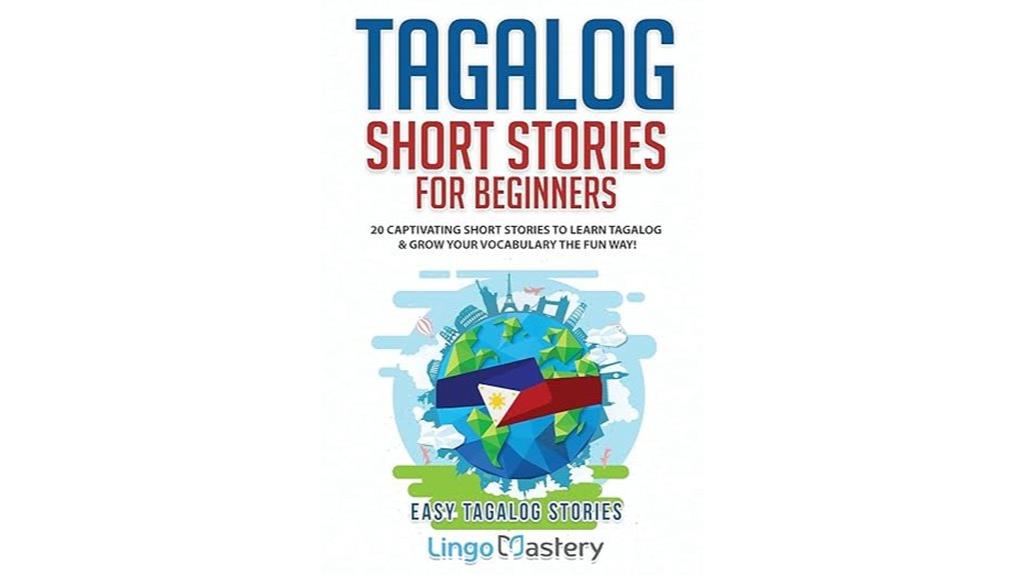
If you’re an advanced beginner or a low intermediate learner of Tagalog, “Tagalog Short Stories for Beginners” might be just what you need. I found its relatable themes like love and resilience engrossing, but be prepared for some challenges. About 50-70% of the vocabulary was unfamiliar to me, and the complex sentence structures can be tricky. I appreciated the emphasis on contextual learning, which helped me connect words to phrases. Just keep a dictionary handy for those tough spots! While the lack of translations is a hurdle, the cultural insights made the effort worthwhile.
Best For: Advanced beginners to low intermediate learners of Tagalog who are looking to expand their vocabulary through engaging stories.
Pros:
- Emphasizes contextual learning, helping readers connect vocabulary to phrases in real-life situations.
- Offers relatable themes such as love and resilience, providing insights into Filipino culture.
- Vocabulary is highlighted in bold, aiding in the learning process despite its complexity.
Cons:
- Many readers may find 50-70% of the vocabulary unfamiliar, making comprehension challenging.
- Lack of full translations can hinder understanding, especially for newer learners.
- Minor errors in text may confuse readers, and the inconsistency in vocabulary selection can be frustrating.
Vocabulary Builder Workbook: Simple Lessons and Activities to Learn 1,400 Words
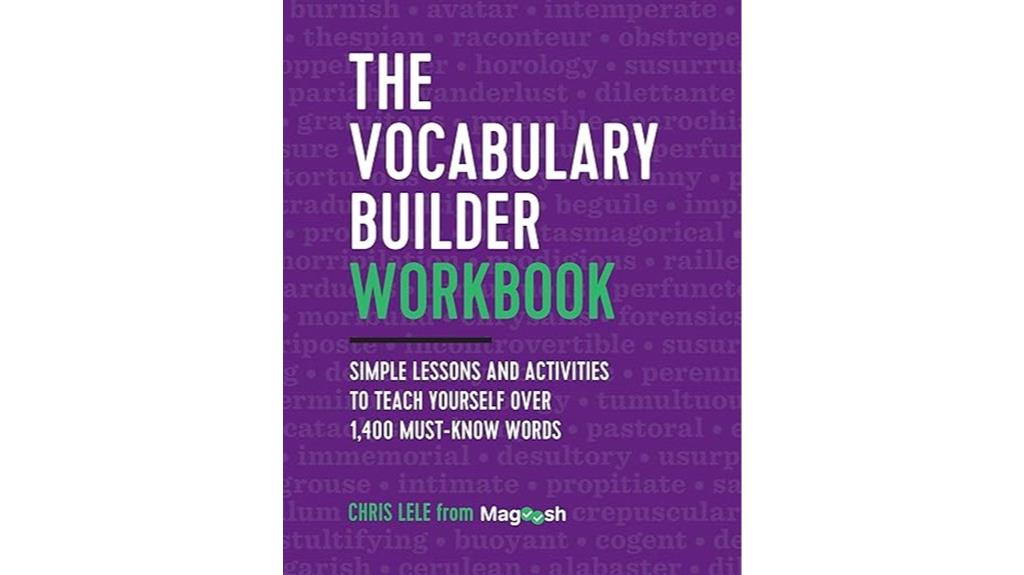
The Vocabulary Builder Workbook is an excellent choice for high school and college students aiming to boost their vocabulary for standardized tests like the ACT, SAT, or GRE. It offers over 1,400 essential words, neatly organized by themes. Each lesson features 7-8 words, complete with definitions, pronunciations, and example sentences. I love how the workbook includes engaging activities that reinforce learning, making it perfect for self-study or classroom use. Users appreciate its structured approach, which enhances retention. While some activities could be more thorough, I find it a valuable resource for anyone looking to expand their vocabulary effectively.
Best For: High school and college students preparing for standardized tests and individuals seeking to enhance their vocabulary skills.
Pros:
- Structured lessons that enhance vocabulary retention.
- Engaging activities that reinforce learning and can be used for self-study or classroom settings.
- Comprehensive coverage of over 1,400 essential words organized by themes.
Cons:
- Some activities may lack depth and could be improved for thorough testing.
- A few words may be considered outdated or less relevant.
- Limited emphasis on reviewing previously learned vocabulary.
Tagalog for Beginners: An Introduction to Filipino
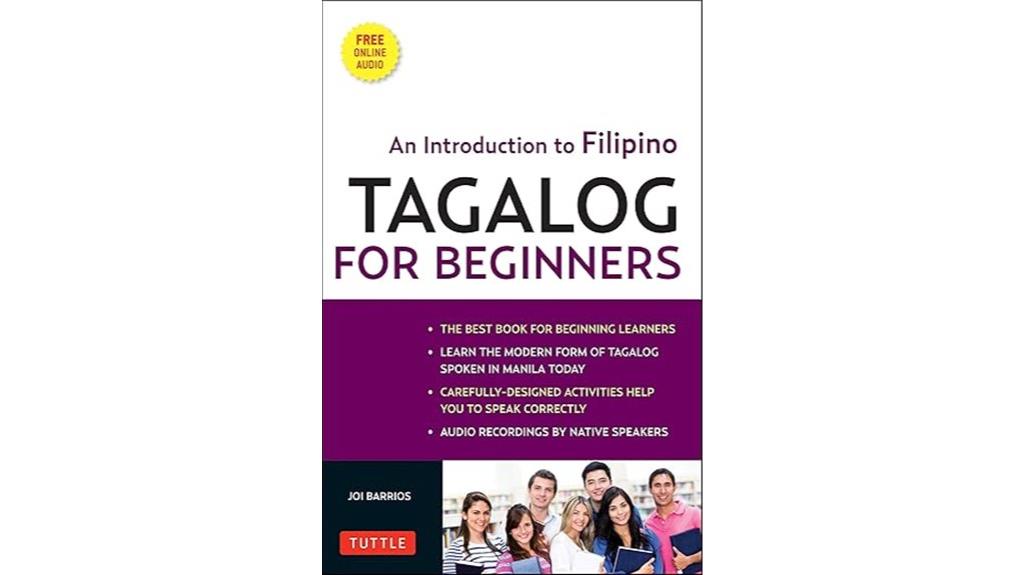
Tagalog for Beginners: An Introduction to Filipino is perfect for travelers enthusiastic to immerse themselves in the vibrant culture of the Philippines. This user-friendly guide helps you learn Tagalog quickly, blending practical language skills with cultural insights. I love how it’s structured for gradual learning, featuring clear explanations and online audio for pronunciation. While it’s great for upper-beginners, some might find it lacks depth for absolute beginners. The comfortable pacing and realistic dialogues make studying enjoyable. Plus, with over 7 hours of audio, it’s an excellent resource for anyone starting their Tagalog journey toward love and connection in the Philippines.
Best For: Travelers to the Philippines and language enthusiasts looking to learn Tagalog quickly and gain cultural insights.
Pros:
- User-friendly structure with clear explanations and gradual learning.
- Extensive audio resources totaling over 7 hours for improved pronunciation and listening skills.
- Realistic dialogues and exercises that make studying enjoyable and applicable to real-life situations.
Cons:
- May not provide enough depth in grammar explanations for absolute beginners.
- Limited translations might leave some learners wanting more clarity.
- Primarily suited for upper-beginners; could be challenging for those with no prior knowledge of Tagalog.
Essential Tagalog Phrasebook & Dictionary

For anyone starting their journey in learning Tagalog, the “Essential Tagalog Phrasebook & Dictionary” stands out as an invaluable resource. I found it perfect for beginners, with over 1500 practical sentences and a handy glossary. The phrases are organized by topic, making it super easy to locate what I need. Plus, the pronunciation tips really helped boost my confidence when speaking. While some translations can be tricky, using this book alongside audio resources enhanced my learning experience. It’s user-friendly and ideal for travelers or anyone wanting to connect with native speakers, making it a must-have for Tagalog learners.
Best For: Beginners learning Tagalog, travelers, and business people seeking practical language skills.
Pros:
- User-friendly format with over 1500 practical sentences organized by topic.
- Effective pronunciation tips that boost confidence in speaking.
- Handy glossary and quick reference indexing for ease of use.
Cons:
- Some translations may contain inaccuracies or complexities.
- Small font size can make reading challenging for some users.
- Better pronunciation guidance needed for unique Tagalog sounds, ideally used with audio resources.
Conversational Tagalog Dialogues: Over 100 Tagalog Conversations and Short Stories

Looking to immerse yourself in the beauty of conversational Tagalog? “Conversational Tagalog Dialogues” is perfect for learners at A1-B1 levels who want to enhance their speaking skills through engaging dialogues. The book features over 100 conversations that tackle everyday situations, like setting meetings or renting cars, making it ideal for travelers. Each dialogue is presented in Tagalog with accurate English translations, allowing for easy comprehension. While it may not reflect all authentic expressions, it’s a great resource to build your vocabulary. Just keep in mind that it lacks an audio component, but it’s still a valuable tool for your learning journey.
Best For: Learners at A1-B1 levels seeking to improve their conversational Tagalog skills through practical dialogues.
Pros:
- Engages learners with over 100 dialogues that address everyday situations.
- Provides Tagalog conversations alongside accurate English translations for easy understanding.
- Aids vocabulary building and conversational skills for both beginners and intermediate learners.
Cons:
- Lacks an accompanying audio resource, which limits pronunciation practice.
- May not reflect culturally authentic expressions used by native speakers.
- Can be challenging for A0 level learners without prior knowledge of Tagalog grammar.
Tagalog Picture Dictionary Coloring Book
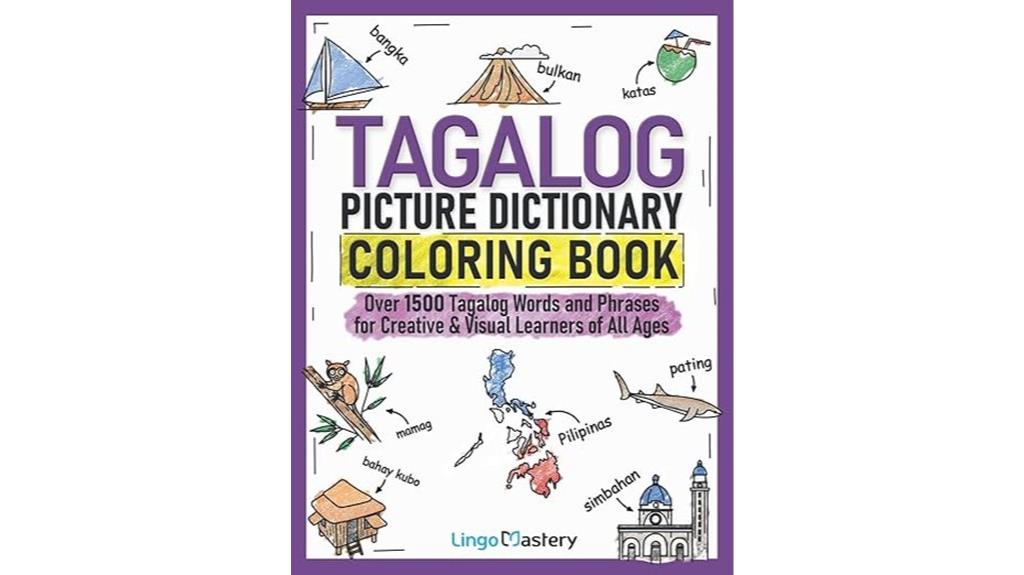
The “Tagalog Picture Dictionary Coloring Book” stands out as an ideal resource for creative and visual learners of all ages, making language acquisition both fun and interactive. With over 1,500 Tagalog words and phrases, this book engages you through coloring and picture-word association. I love its detailed illustrations and quizzes that reinforce learning. It’s perfect for anyone wanting to learn Tagalog, especially travelers heading to the Philippines. I recommend using it with a friend or tutor for storytelling and conversation practice. Overall, it’s a delightful way to build vocabulary while sparking creativity and enjoyment in learning!
Best For: The “Tagalog Picture Dictionary Coloring Book” is best for creative and visual learners of all ages, particularly those preparing for travel to the Philippines.
Pros:
- Engaging and interactive learning experience through coloring and illustrations.
- Includes quizzes to reinforce vocabulary and understanding.
- Suitable for all ages, making it a fun resource for families and groups.
Cons:
- May not cover advanced grammar or complex linguistic structures.
- Requires additional resources for comprehensive conversational practice.
- Limited to visual and auditory learners; may not suit all learning styles.
Tagalog Made Easy Level 1: Textbook + Workbook for Beginners
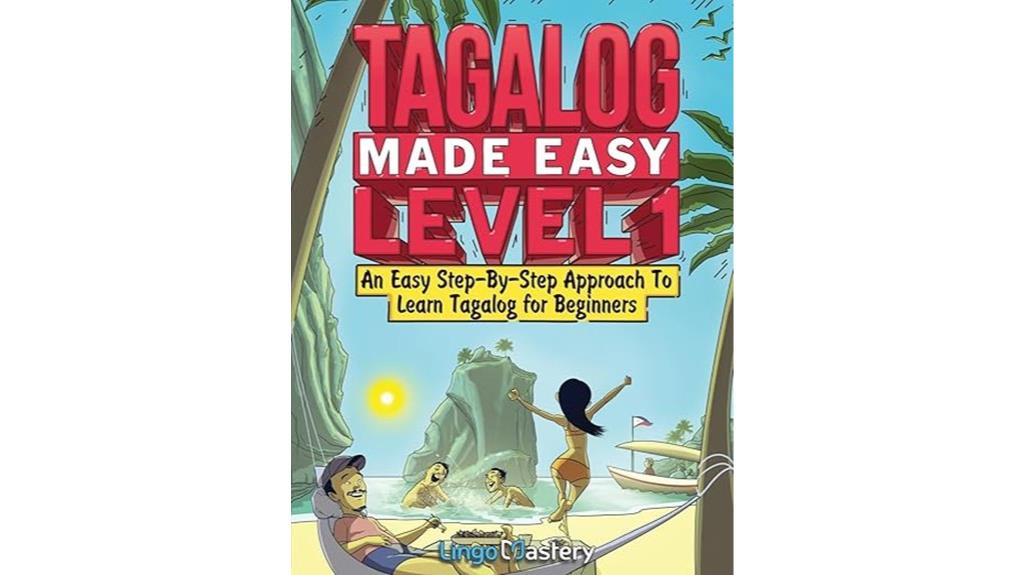
Tagalog Made Easy Level 1 is perfect for anyone enthusiastic to immerse themselves in the Tagalog language, especially those with a personal connection to the Filipino community, like dating a Filipina. This textbook and workbook combo provides a structured approach that’s easy to follow. You’ll learn the alphabet, pronunciation, and grammar while engaging in practical exercises. The cultural insights enhance your understanding of Filipino traditions, making it more than just a language book. Plus, the accompanying audio files and engaging visuals make learning enjoyable. I highly recommend it for beginners keen to connect with the language and culture.
Best For: Beginners looking to learn Tagalog, especially those with personal connections to the Filipino community.
Pros:
- Clear and structured step-by-step approach for easy learning.
- Engaging visuals and audio resources enhance the learning experience.
- Includes cultural insights that provide context and deepen understanding of Filipino traditions.
Cons:
- May not be suitable for advanced learners or those seeking in-depth grammar analysis.
- Limited to beginner-level content, requiring additional resources for further proficiency.
- Some users may find the pace too slow if they have prior language learning experience.
English – Romanian Bilingual First Top 624 Words Educational Activity Book for Kids
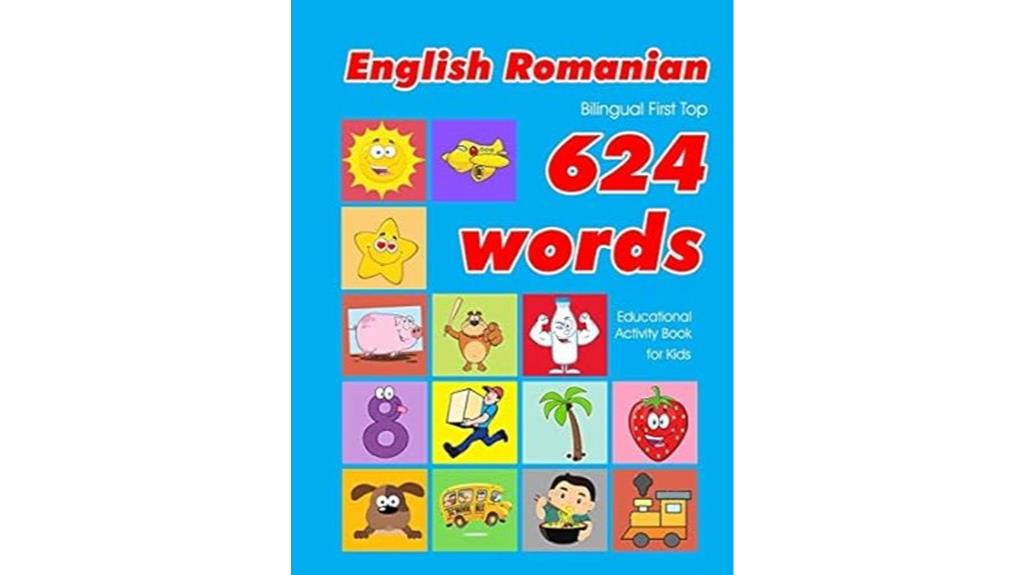
For parents seeking an engaging way to introduce their little ones to language, the “English – Romanian Bilingual First Top 624 Words Educational Activity Book for Kids” stands out as an excellent resource. It features 624 basic words and black-and-white pictures, helping toddlers identify their surroundings. However, I’ve noticed some significant issues, like inaccurate translations and cultural irrelevances. Despite its educational intent, the book’s production quality seems lacking, resembling a home office project. While flashcards are great for development, I’d recommend exploring other resources to guarantee your child receives accurate and meaningful language learning experiences.
Best For: Parents looking for a basic bilingual vocabulary resource for toddlers aged 1 to 6.
Pros:
- Engages children with visuals and vocabulary across various categories.
- Encourages memory development and language recognition in young learners.
- Flashcards can be utilized for interactive games and conversations.
Cons:
- Contains inaccurate translations and misunderstandings of grammar rules.
- Production quality is poor, resembling a home office project rather than a professionally produced book.
- Some words included are culturally irrelevant or poorly labeled, reducing educational value.
Twelfth Night (Folger Shakespeare Library)
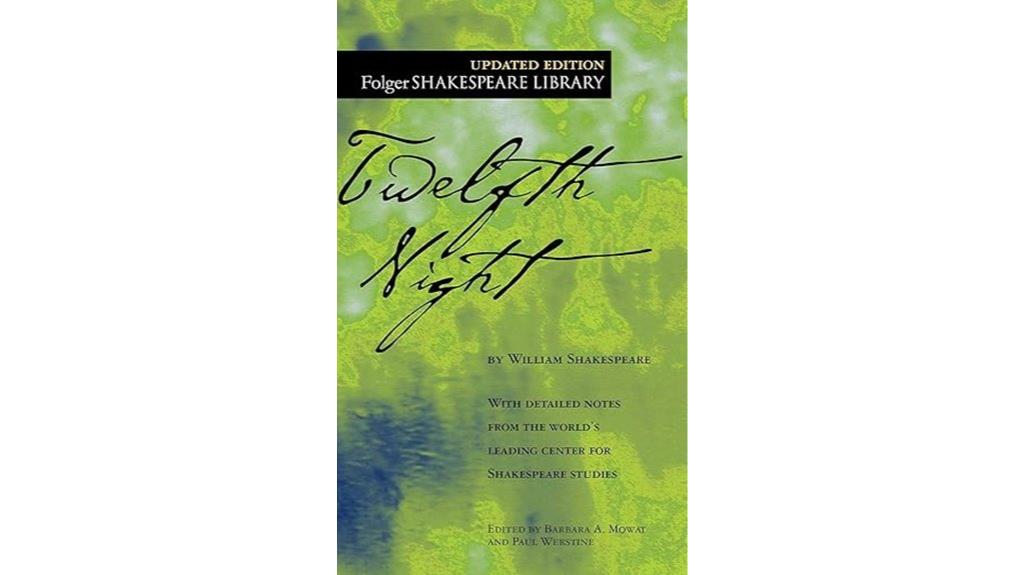
If you’re looking to blend the charm of romance with the beauty of the Tagalog language, then “Tagalog Vocabulary Books for Romance” is an ideal choice. I recently revisited “Twelfth Night” from the Folger Shakespeare Library, and it struck me how love and identity intertwine seamlessly in the play. Viola’s clever disguise leads to unexpected love triangles that are both humorous and poignant. The characters, especially Olivia and Malvolio, add depth to the comedy, even if Orsino feels a bit underdeveloped. This edition’s layout makes Shakespeare’s language accessible, making it a delightful read for anyone exploring love’s complexities.
Best For: Readers seeking an accessible introduction to Shakespeare that highlights themes of love and identity in a comedic context.
Pros:
- Engaging plot that intertwines romance and humor, making it enjoyable for a wide audience.
- Accessible layout with explanatory notes and scene summaries that aid comprehension of Shakespeare’s language.
- Rich character interactions that provide depth to the comedy, particularly through the dynamics between Viola, Olivia, and Malvolio.
Cons:
- Underdeveloped characters, particularly Orsino, which may leave some readers wanting more depth.
- Mixed reception compared to Shakespeare’s other works, as some readers feel it lacks the depth found in plays like Much Ado About Nothing.
- Pacing issues that may affect the overall flow of the narrative for some audiences.
Conversational Tagalog Dialogues Book
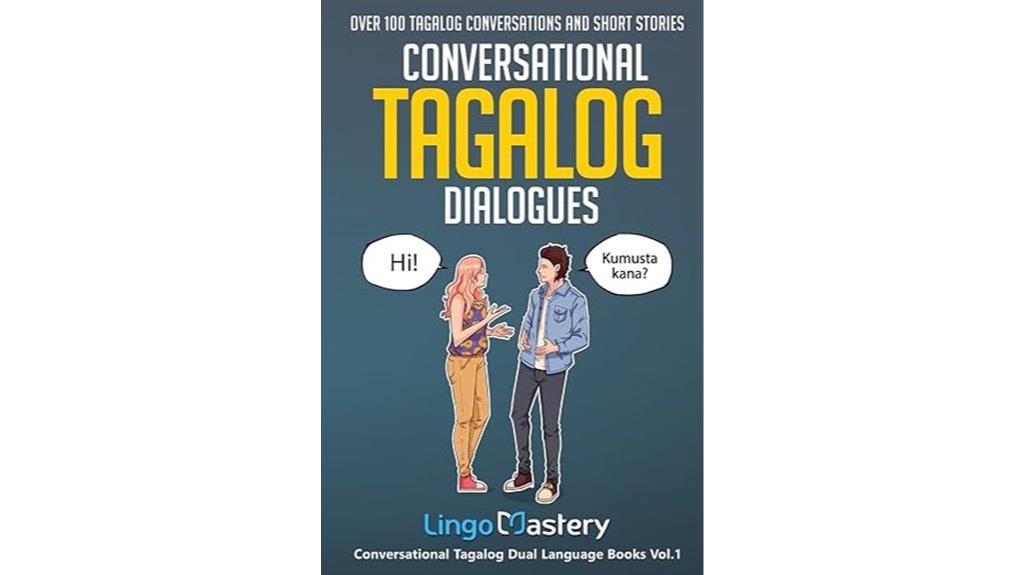
Looking to enhance your conversational skills in Tagalog? “Conversational Tagalog Dialogues” is an excellent choice for learners at the A1-B1 levels who often find themselves maneuvering everyday scenarios like ordering food or arranging travel plans. With over 100 dialogues, this book introduces you to essential conversations, making it perfect for travelers. Each dialogue presents Tagalog first, followed by English translations, so you can practice easily. While it lacks audio resources, it’s still a fantastic tool, especially if you have access to a native speaker. You’ll gain exposure to the language and boost your confidence in real-life situations.
Best For: Learners at A1-B1 levels looking to improve their conversational Tagalog skills for everyday situations.
Pros:
- Provides over 100 engaging dialogues that cover common scenarios.
- Includes accurate English translations for easy reference and practice.
- Ideal for travelers to the Philippines who want to enhance their language skills.
Cons:
- Lacks accompanying audio resources, which can hinder pronunciation practice.
- May be challenging for A0 level learners without prior knowledge of Tagalog grammar.
- Dialogues may not reflect culturally authentic expressions used by native speakers.
English Tagalog Picture Dictionary for Kids
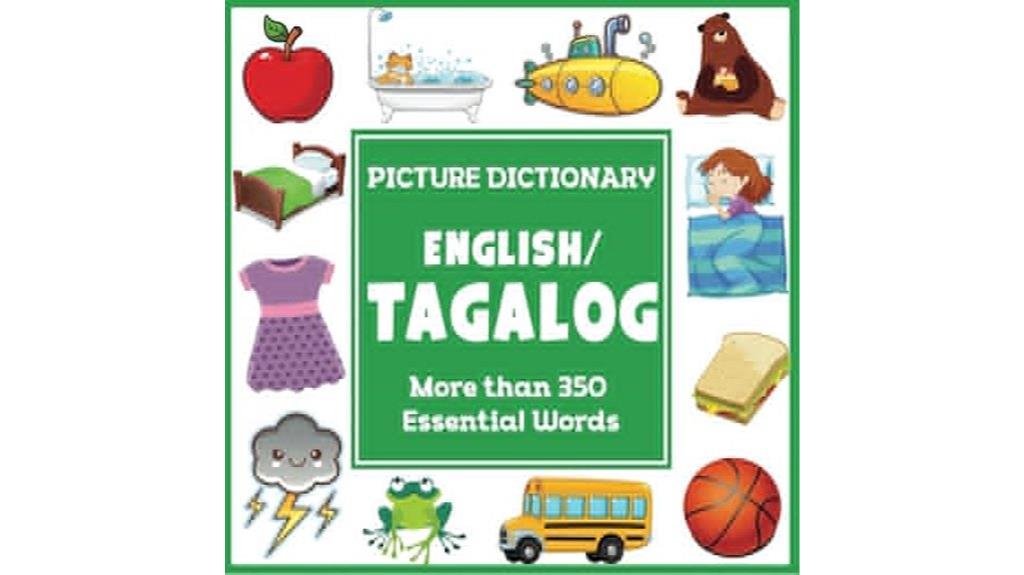
The English Tagalog Picture Dictionary is perfect for bilingual kids enthusiastic to explore the Tagalog language. With over 50 pages of colorful illustrations and more than 350 essential words, it makes learning fun and engaging. Each page pairs English and Tagalog side by side, helping kids grasp vocabulary effortlessly. The simple pronunciation guide guarantees they can say the words correctly. Covering topics like family, animals, colors, and emotions, this dictionary caters to various interests. It’s an excellent resource for Tagalog-speaking families or anyone new to the language. Start your child’s bilingual journey today and nurture their love for language learning!
Best For: Bilingual kids eager to learn Tagalog through engaging illustrations and vocabulary.
Pros:
- Over 350 essential words make it comprehensive for beginners.
- Vibrant illustrations enhance the learning experience and keep children engaged.
- Dual-language format supports both English and Tagalog learning side by side.
Cons:
- May not cover advanced vocabulary for more experienced learners.
- Limited to everyday topics, which might not cater to specialized interests.
- The pronunciation guide may not be sufficient for all learners, requiring additional resources for mastering pronunciation.
69 Short Tagalog Stories for Beginners
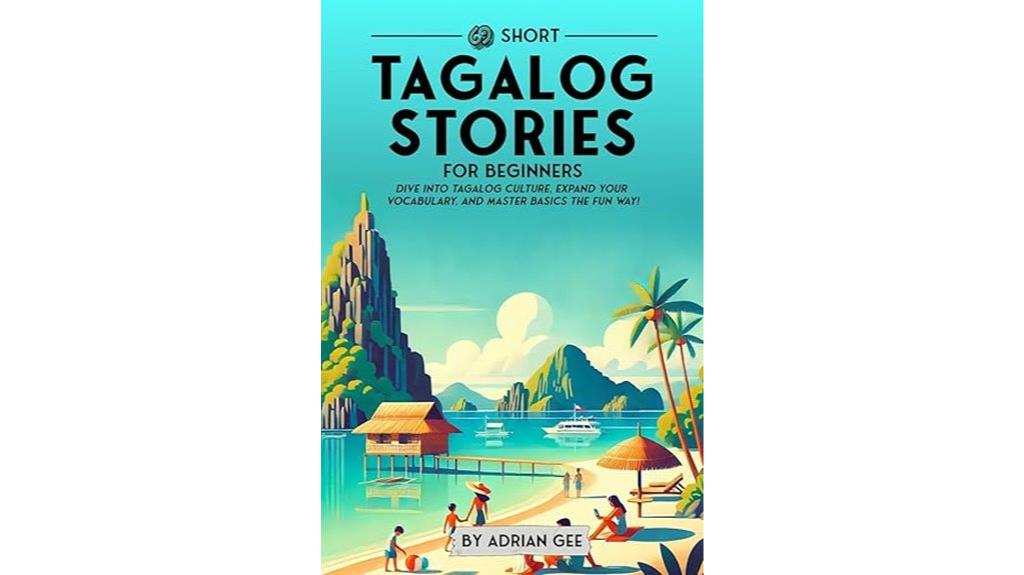
For anyone enthusiastic to plunge into the Tagalog language, “69 Short Tagalog Stories for Beginners” is an excellent choice. This collection is perfect for A1/A2 level learners like me who want to build a solid foundation while enjoying engaging stories. Each tale introduces over 1,000 high-frequency words and phrases, making vocabulary acquisition feel natural. I love how the stories offer cultural insights, enhancing my connection to the language. Plus, the interactive exercises help me track my progress and reinforce what I’ve learned. It’s a fun and effective way to immerse myself in Tagalog and its beautiful culture!
Best For: This book is best for A1/A2 level learners seeking to develop their Tagalog language skills while enjoying engaging stories and cultural insights.
Pros:
- Engaging and accessible stories that introduce over 1,000 high-frequency words and phrases.
- Provides cultural insights, enhancing the learner’s connection to the Tagalog language and culture.
- Includes interactive exercises for progress tracking and reinforcement of learning.
Cons:
- Limited to beginner-level content, which may not challenge more advanced learners.
- Some readers may find the cultural references unfamiliar or challenging without additional context.
- The focus on high-frequency words may overlook less common but important vocabulary for specific contexts.
Beginners Tagalog Word Searches – Volume 1 (Tagalog Edition)
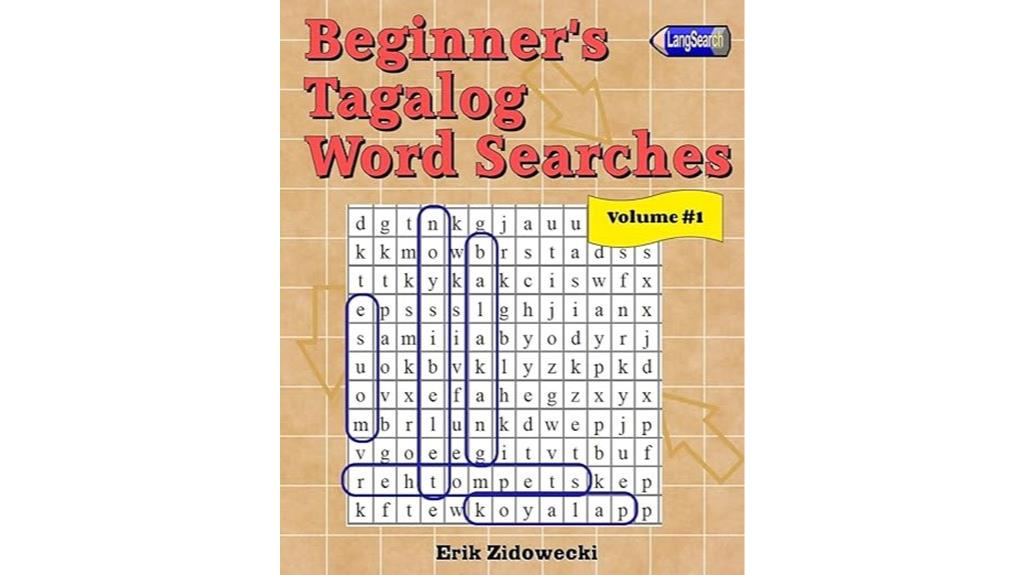
Beginners Tagalog Word Searches – Volume 1 (Tagalog Edition) is perfect for anyone enthusiastic to plunge into the Tagalog language while having fun. With 100 engaging puzzles, I found it a fantastic way to learn new vocabulary. Each puzzle pairs Tagalog words with English, making it easier to connect meanings. The themed categories, from animals to food, kept things interesting and broadened my vocabulary. I enjoyed searching for words in different orientations—horizontally, vertically, and diagonally. While there are some editing issues with Portuguese words, the overall experience is enjoyable, providing hours of educational fun for learners of all ages.
Best For: Beginners eager to learn Tagalog in a fun and engaging way through word puzzles.
Pros:
- Engaging concept for students and kids, offering hours of learning fun.
- Themed categories like animals, food, and clothing enhance vocabulary range.
- Puzzles feature a mix of orientations, making the search more challenging and enjoyable.
Cons:
- Editing issues with Portuguese words, leading to misspellings.
- Some puzzles may be too challenging for complete beginners without guidance.
- Limited explanations for vocabulary may leave learners wanting more context.
Factors to Consider When Choosing Tagalog Vocabulary Books for Romance

When choosing Tagalog vocabulary books for romance, I think it’s essential to contemplate your target audience and their familiarity with the language. You’ll want to look at the complexity of vocabulary included, as well as how well the book incorporates cultural context and grammar insights. Finally, interactive learning features can really enhance the experience and make it more enjoyable.
Target Audience Considerations
Choosing the right Tagalog vocabulary books for romance involves several key considerations that can greatly enhance your learning experience. First, think about your language proficiency level; some books are tailored for advanced beginners or intermediate learners, not absolute newbies. Next, consider the cultural context—romance in the Philippines has its unique nuances, so books with relevant themes will help you connect better. Your demographic, including age and background, also matters; it can make the vocabulary more relatable. I’ve found that books featuring dialogues or romantic scenarios are particularly effective for practicing conversational skills. Finally, verify the books offer thorough support, like grammar explanations and pronunciation guides, to navigate those complex romantic expressions in Tagalog.
Vocabulary Complexity Levels
Understanding vocabulary complexity levels is vital in selecting the right Tagalog vocabulary books for romance. I’ve noticed that these books can vary greatly, often targeting advanced beginners to low intermediate learners, with 50-70% of the vocabulary being unfamiliar. Some resources explore complex sentence structures, which can even challenge native speakers. That’s why it’s important to choose a book that matches your current level; beginner books usually focus on high-frequency words and simple phrases. I prefer resources that use contextual learning through stories, as they help me grasp meanings within relatable themes. Finally, consistency in vocabulary selection matters—mixing elementary and advanced words can confuse learners at different stages, so I always check that before engaging.
Cultural Context Inclusion
Incorporating cultural context into Tagalog vocabulary books for romance can markedly enhance your learning experience. Understanding Filipino customs and traditions around love enriches your vocabulary acquisition, as many romantic expressions are rooted in these cultural nuances. You’ll find that terms related to courtship and familial respect are essential for meaningful conversations. Look for books that include cultural narratives or stories that illustrate romantic relationships; these relatable scenarios help you see how language operates in context. Recognizing local idioms and metaphors is also important, as they add depth to your comprehension of emotional expressions. Engaging with materials that weave in these cultural elements allows you to appreciate the subtleties of romantic communication in Tagalog even more.
Grammar and Structure Insights
When diving into Tagalog vocabulary books for romance, I find it essential to pay attention to grammar and sentence structure. Some books dive deep into complex syntax, which can be overwhelming, especially for intermediate learners. I’ve noticed that many resources mix elementary and advanced words, causing confusion. It’s critical to choose books that maintain a consistent difficulty level, particularly around romantic themes. I also prefer materials that contextualize vocabulary within relatable love and relationship scenarios, as this enhances my understanding. A strong focus on conversational phrases and dialogues is important, too, as it helps me navigate romantic interactions more effectively. Finally, resources that explain cultural nuances in romantic expressions greatly enrich my learning experience.
Interactive Learning Features
Selecting Tagalog vocabulary books for romance isn’t just about the words themselves; it’s also about how those words come to life through interactive learning features. I’ve found that books with quizzes and exercises really enhance vocabulary retention, allowing me to apply new words in different contexts. Vocabulary lists paired with contextual examples help me connect words to their meanings, deepening my understanding. I love engaging formats like word searches or fill-in-the-blank activities, which make learning enjoyable. Additionally, audio resources improve my pronunciation and listening skills, essential for mastering Tagalog. Books that include interactive dialogues and cultural insights also encourage me to practice conversational skills, showing me how to use vocabulary in real-life situations.
Real-Life Application Scenarios
Engaging with Tagalog vocabulary books that focus on romance opens up a world of real-life application scenarios. When I choose these books, I look for ones that enhance my understanding of relationship dynamics and cultural nuances. I find it vital to include common phrases and idiomatic expressions related to love, dating, and relationships, as they greatly improve my conversational skills. I also prefer materials that feature dialogues depicting romantic interactions, providing practical examples that I can relate to. Resources incorporating vocabulary about emotions and expressions of affection are essential for meaningful communication. Finally, books offering cultural insights help me navigate the complexities of Filipino romance, making my interactions feel more authentic and impactful.
Supplementary Resources Availability
While exploring Tagalog vocabulary books for romance, I always consider the availability of supplementary resources. Books that include audio recordings or vocabulary lists help enhance my learning experience. Interactive exercises and quizzes make the material more engaging, ensuring I retain what I learn. I also appreciate when books connect me to online forums or communities; these platforms provide valuable support and practice opportunities. Cultural insights within the vocabulary books deepen my understanding of social interactions, especially in romantic contexts. Additionally, I look for recommendations or links to external resources like flashcard apps or language exchange platforms, which further support my vocabulary acquisition in real-life situations. Finding these resources makes my learning journey more effective and enjoyable.
Frequently Asked Questions
Are There Tagalog Vocabulary Books Specifically Focused on Romantic Phrases?
I’ve often wondered if there are Tagalog vocabulary books that focus specifically on romantic phrases. While I haven’t found a dedicated book just for that, many general Tagalog resources include sections on love and relationships. I’ve found that these phrases can really enhance conversations with someone special. If you dig deeper into language learning resources, you might stumble upon collections that cater to romance in the beautiful Tagalog language.
How Can I Practice Speaking Tagalog With a Partner?
Practicing Tagalog with a partner can be both fun and intimidating. I’ve found that setting regular conversation sessions helps me gain confidence. Try mixing structured lessons with spontaneous chats. One moment, we might be practicing vocabulary, and the next, we’re laughing over a shared joke. Role-playing different scenarios, like ordering food or planning a trip, keeps it engaging. Don’t hesitate to make mistakes; it’s all part of the learning process!
What Are Common Tagalog Love Expressions?
When I think about common Tagalog love expressions, a few phrases always come to mind. “Mahal kita” means “I love you,” and it’s a must-know. I also love saying “Ikaw ang aking puso,” which means “You are my heart.” Another sweet one is “Sana’y maging tayo,” or “I hope we become us.” Using these phrases really helps me express my feelings and connect deeper with my partner. It’s so rewarding!
Can I Find Online Resources for Learning Romantic Tagalog Vocabulary?
Absolutely, I’ve found plenty of online resources for learning romantic Tagalog vocabulary. Websites like Duolingo and Memrise offer engaging lessons, while YouTube has videos dedicated to love expressions. I’ve even stumbled upon forums where native speakers share tips and phrases. Social media platforms can be gold mines too, as you can follow accounts focused on Tagalog culture and language. With a little search, you can immerse yourself in the beauty of romantic Tagalog!
Are There Tagalog Romance Novels That Include Vocabulary Lessons?
I’ve come across several Tagalog romance novels that incorporate vocabulary lessons. These books often weave in language tips alongside the story, making it easier to learn while enjoying the plot. I love how they use context to teach new words and phrases. I recommend checking out online platforms where readers discuss these titles, as they can guide you to the best options for blending romance and language learning seamlessly.
Conclusion
In summary, diving into these Tagalog vocabulary books is like revealing a treasure chest of romance! Each page brings you closer to the heart of the Philippines, where love stories bloom like flowers in spring. Whether you’re mastering flirtatious phrases or uncovering the secrets of sweet serenades, you’ll feel like a linguistic Cupid, ready to conquer hearts. So grab one of these gems, and let your journey to love and language begin—it’s bound to be an unforgettable adventure!









